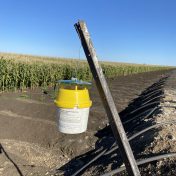Native armyworm species are currently present in many young maize and sorghum crops across southern and central Queensland. Sometimes it is just the occasional larva, but in other situations native armyworms are at higher densities than fall armyworm (FAW). As far as we know, native armyworm are far less damaging to establishing crops than FAW and are unlikely to cause… Read more »
Earlier this year, the Queensland Department of Primary industry (DPI) pathology team received samples of soybean with virus-like symptoms. Diseased plants displaying strong chlorotic mottle on leaves and leaf crinkling (see images below) were scattered through the crop. While the samples tested positive in a polymerase chain reaction (PCR) test for potyvirus, the actual species remained a mystery. Subsequent sequencing… Read more »
The biggest challenge when storing grain is dealing with insects (such as weevils) and prevention is ALWAYS better than cure. Controlling insects once they infest grain can only be done with fumigation or controlled atmosphere, both of which require gas-tight sealable storage. For storages that cannot be sealed, prevention is our only management option, short of transferring grain out via… Read more »
As part of the cotton industry’s proactive approach to managing resistance risks, there is an ongoing program of resistance surveillance in the major pest species. Resistance to spirotetramat (Movento®) was first detected in silverleaf whitefly (SLW) in the Burdekin region in 2016. From 2016–2024, 131 SLW populations have been collected and tested for resistance to spirotetramat, 4 populations were from… Read more »
The Field Crops Entomology Team at the Queensland Department of Agriculture and Fisheries has recently established a new moth pheromone trapping network to inform the northern grains industry of the seasonal population patterns of key caterpillar pests. A collaborative network of more than 25 growers and agronomists are assisting the monitoring of pheromone traps in 20 locations across 10 regions…. Read more »
Since 2022, an insecticide resistance surveillance program for fall armyworm (FAW) has been conducted annually by NSWDPIRD in collaboration with DAF entomologists. Resistance to older products, such as carbamates (Group 1A), organophosphates (Group 1B) and pyrethroids (Group 3A) has been confirmed in many FAW populations worldwide, and there are concerns that the increase in spraying to control FAW may lead… Read more »
As winter cereals, canola and pulses flower and fill grain, and temperatures rise, the risk of infestation by caterpillar pests increases. Below is a quick refresher on the risk of infestation and crop loss by common caterpillar pests: helicoverpa, native armyworms and fall armyworm. Key points: There is increased risk of infestation by Helicoverpa armigera this spring because of the… Read more »
Recent weather conditions have led to isolated outbreaks of two fungal diseases, fusarium crown rot and sclerotinia stem rot, in several grain crops across southern Queensland. Crown rot Crown rot, primarily caused by Fusarium pseudograminearum, has been detected in several barley crops across southern Queensland, but other winter cereal crops and regions are also at risk. Initial disease symptoms include… Read more »
There have been reports of sporadic moderate to high mouse activity from several Australian grain growing regions, including southern Queensland, where 3 sites had high activity (with up to 800 burrows/ha at one site). See the April GRDC/CSIRO Mouse Update for more information. High mice numbers when winter crops are planted can result in significant economic damage, and summer crops… Read more »
QDAF entomologists have recently inspected several infestations of fall armyworm (FAW) in forage oats on the Darling Downs. Oats are not a preferred host of FAW, but these infestations come at the end of the largest FAW season since the pest arrived in Australia. Oats are not usually inspected for pest insects, but agronomists are advised to check plants for… Read more »










